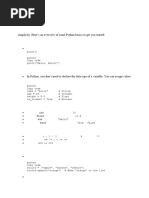0 ratings0% found this document useful (0 votes)
6 viewsQuick Guide To Python Basics ?
Uploaded by
enumanikyleCopyright
© © All Rights Reserved
We take content rights seriously. If you suspect this is your content, claim it here.
Available Formats
Download as DOCX, PDF, TXT or read online on Scribd
0 ratings0% found this document useful (0 votes)
6 viewsQuick Guide To Python Basics ?
Uploaded by
enumanikyleCopyright
© © All Rights Reserved
We take content rights seriously. If you suspect this is your content, claim it here.
Available Formats
Download as DOCX, PDF, TXT or read online on Scribd
You are on page 1/ 2
Quick Guide to Python Basics 🚀
1. Data Types
Numbers: Whole numbers (integers) and decimal numbers (floats). Example: 5
(integer), 3.14 (float).
Strings: Text wrapped in quotes. Example: "Hello, World!".
Booleans: True or False values. Example: True, False.
2. Variables
Think of variables as containers for storing data. You give them a name and store a
value in them. Example: name = "Alice".
3. Numbers
Integers: Whole numbers like 7 or -3.
Floats: Numbers with decimals like 2.5 or -0.1.
4. Strings
Creation: Use quotes to create strings. Example: greeting = "Hi there!".
Concatenation: Join strings together with +. Example: "Hello " + "World" results in
"Hello World".
5. Casting
Convert one type to another. Example:
From number to string: str(5) gives "5".
From string to number: int("7") gives 7.
6. Booleans
True and False are used to check conditions. Example: x > 10 returns True if x is
greater than 10.
7. Operators
Arithmetic Operators: + (addition), - (subtraction), * (multiplication), / (division).
Comparison Operators: == (equal to), != (not equal to), > (greater than), < (less
than).
You might also like
- Python_Fundamentals_Presentation nverseenNo ratings yetPython_Fundamentals_Presentation nverseen11 pages
- Familiarization with the Basics of Python ProgrammingNo ratings yetFamiliarization with the Basics of Python Programming47 pages
- 1971 - 981 - DOC - Introduction To Python and Basic SyntaxNo ratings yet1971 - 981 - DOC - Introduction To Python and Basic Syntax6 pages
- Cours Python - Seance1 - Introduction Et Concepts de BaseNo ratings yetCours Python - Seance1 - Introduction Et Concepts de Base12 pages
- Python Programming Basics – A Beginner’s GuideNo ratings yetPython Programming Basics – A Beginner’s Guide2 pages
- Python for Data Science, AI & DevelopmentNo ratings yetPython for Data Science, AI & Development10 pages
- Effects of Human Trafficking On Nigerian YouthsNo ratings yetEffects of Human Trafficking On Nigerian Youths2 pages
































































